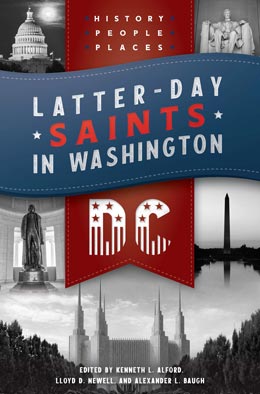“Make the Air with Music Ring”: A Personal Perspective of the Tabernacle Choir at Temple Square
Lloyd D. Newell
Lloyd D. Newell, “'Make the Air with Music Ring': A Personal Perspective on the Tabernacle Choir at Temple Square,” in Latter-day Saints in Washington, DC: History, People, and Places, ed. Kenneth L. Alford, Lloyd D. Newell, and Alexander L. Baugh (Provo, UT: Religious Studies Center, Brigham Young University; Salt Lake City: Deseret Book), 115‒34.
Lloyd D. Newell was a professor of Church history and doctrine at Brigham Young University when this was published who had served for three decades as the announcer and writer of Music and the Spoken Word.
The Mormon Tabernacle Choir has become so much a part of America.
I think of it as being like the Grand Canyon or Mount Rushmore.[1]
—Charles Osgood
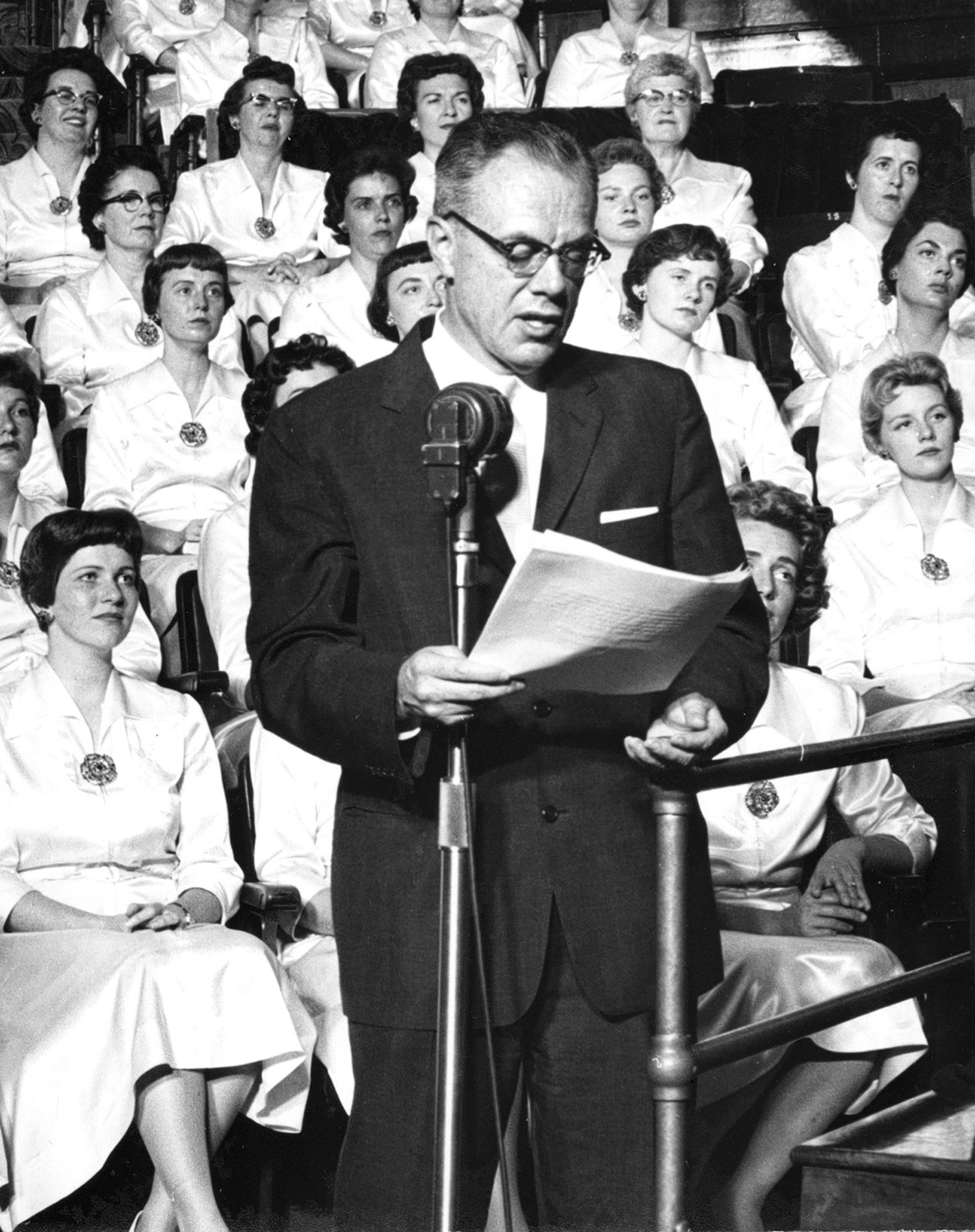 Richard L. Evans at Music and the Spoken Word. © Intellectual Reserve, Inc.
Richard L. Evans at Music and the Spoken Word. © Intellectual Reserve, Inc.
My involvement with the Tabernacle Choir at Temple Square spans more than three decades. Music and the Spoken Word, the choir’s weekly broadcast, began its ninetieth year in July of 2019. But to really tell the story of this remarkable choir, you have to go back to at least the summer of 1847.
That was when trail-weary pioneers began planting crops in their new home, the wilderness of the Salt Lake Valley. A lot depended on the success of those crops. But the pioneers seemed to sense that they were doing more than just establishing an agricultural community; they were creating a religious haven. They were building the kingdom of God. So every Sunday, they set aside the plow and gathered for worship services under a crude bowery of brush and branches.[2] From the beginning, their worship included songs of praise, and a favorite was “Come, Come, Ye Saints,” an anthem by William Clayton with lines that describe well their singing in the desert:
We’ll make the air with music ring,
Shout praises to our God and King. . . .
Oh, how we’ll make this chorus swell—
All is well! All is well![3]
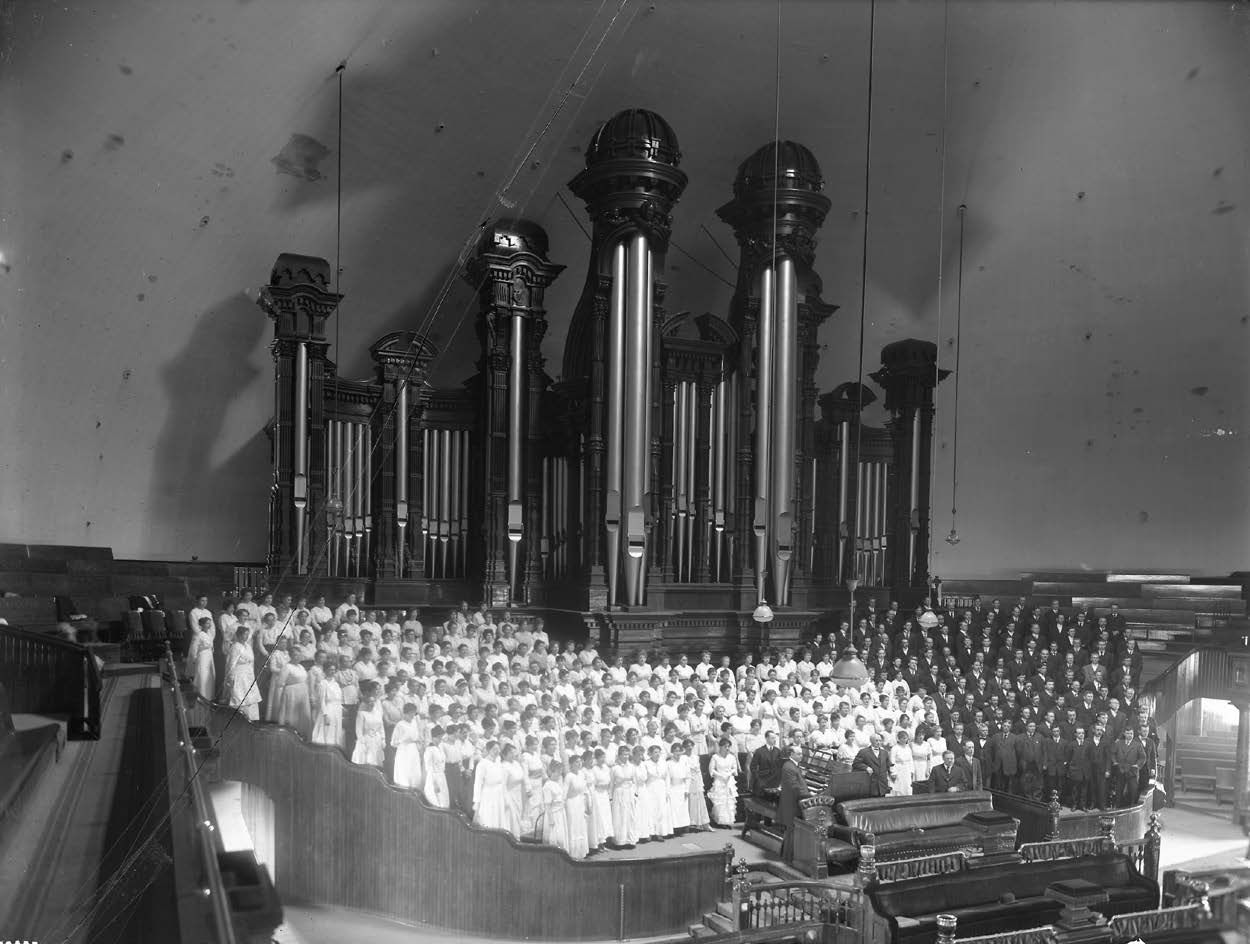 The Tabernacle Choir has provided more than ninety years of continuous network broadcasting. Church History Library.
The Tabernacle Choir has provided more than ninety years of continuous network broadcasting. Church History Library.
Needless to say, there were not many choirs like this one making the dry western air ring with praise in 1847. These were not your typical fur trappers, prospectors, explorers, or homesteaders seeking a grubstake in the West. No, these were humble religious folk who had been converted to The Church of Jesus Christ of Latter-day Saints, primarily from western Europe and the northeastern United States. Most of them would just as soon have remained in their comfortable settlements in Nauvoo, Illinois, and the surrounding areas. But religious persecution drove them away, and their prophetic leader, Brigham Young, led them west in search of peace and religious freedom. It was love of God, not love of adventure or open spaces, that brought them to “the place which God for us prepared, far away in the West.”[4] They took with them what they could carry in a wagon and in their hearts—courage, tenacity, faith in God, and, of course, a love of singing.
And so it was that just months after the first wagons rolled into the barren Salt Lake Valley, Brigham Young asked John Parry (from Wales) to prepare a choir for the Church’s first general conference in the Great Basin.[5] Prophetic though he was, could Brother Brigham have known that he had just founded what would become arguably the most widely recognized choir in the world?
The choir rehearsed twice weekly and sang at all kinds of Church functions and community celebrations. The choir first made its home on Temple Square in an outdoor bowery, but the Saints quickly outgrew it and the small building that replaced it. In April 1863, Church leaders announced plans to build a massive tabernacle to accommodate its quarterly general conferences, along with other religious and community events. The intent was to seat as many as ten thousand—ambitious plans for a group that only sixteen years earlier was clattering down Emigration Canyon in covered wagons.
The staggering cost of three hundred thousand dollars was amassed in donations from the people, much of it in the form of building materials, bread, vegetables, jewelry, clothing, and labor. The building was usable by 6 October 1867 and formally finished and dedicated in October 1875. The choir has been singing in the Salt Lake Tabernacle ever since.[6]
Besides its iconic pipe organ, the Tabernacle is known for its spectacular acoustics and vibrant sound, making it the perfect home for a choir. The Tabernacle has carried the distinctive sounds of the choir clearly and faithfully for more than 150 years, so it is fitting that the Tabernacle Choir would carry the Tabernacle’s name.
Before long, the choir set out to share its gifts outside the Salt Lake Valley. This included participating in an eisteddfod, a renowned choral competition, at the Columbian Exposition at the 1893 World’s Fair. Four hundred choir members and support personnel traveled to Chicago on a ten-car train for the event. It had been less than fifty years since their wagon trains had made their trek in the opposite direction, and some of those pioneers were now among the singers returning to Illinois.
The music at the competition was not for the fainthearted: “Worthy Is the Lamb,” from Handel’s Messiah; “Blessed Is the Man Who Fears Him,” from Mendelssohn’s Elijah; and “Now the Impetuous Torrents Rise,” from the oratorio David and Saul. The choir took second place to a combined choir from Scranton, Pennsylvania, although the judges admitted, “It was in reality very difficult to determine who were the victors, the Scranton or the Tabernacle singers, the contestants being so nearly equal, and the degree of excellence with each on all points being of such a high standard.” The runners-up were not disheartened, feeling “that in a contest of such magnitude, to be almost if not equal to the best talent the country could produce, was something for the West to be proud of.”[7]
Over the next few years, the choir performed in Denver (1896), the San Francisco World’s Fair (1902), the Yukon Exposition in Seattle (1909), New York (1911), and Washington, DC (1911). But nationwide exposure was about to reach a major turning point because of a new communication technology that would change the world.
Music and the Spoken Word
In the 1920s, radio fascinated the public. All across the country, people began to recognize its tremendous possibilities. In Utah, a tiny radio station called KZN—later known as KSL—was launched by The Church of Jesus Christ of Latter-day Saints in 1922 as an offshoot of the Church-owned newspaper, the Deseret News. An NBC radio affiliate, KZN broadcast from the roof of a building in downtown Salt Lake City. Its first broadcast, on 6 May 1922, was a message from Church President Heber J. Grant. Within a few years, Latter-day Saints listened to the first radio broadcast of general conference, and listeners in Salt Lake City could tune in to Tabernacle choir rehearsals every Thursday evening.
Soon afterward, station manager Earl J. Glade had a brilliant idea: a nationwide, weekly broadcast of the Tabernacle Choir. He convinced both the choir and NBC management that it could be done. So on 15 July 1929 they gave it a try. By today’s standards, it was a low-tech production: a young announcer, Ted Kimball, climbed a fifteen-foot ladder and spoke into a single microphone (borrowed from the radio station); a technician stood on the basement stairs so he could communicate with headquarters in New York by telegraph; and Music and the Spoken Word was born. Thirty radio stations received that first transmission.[8]
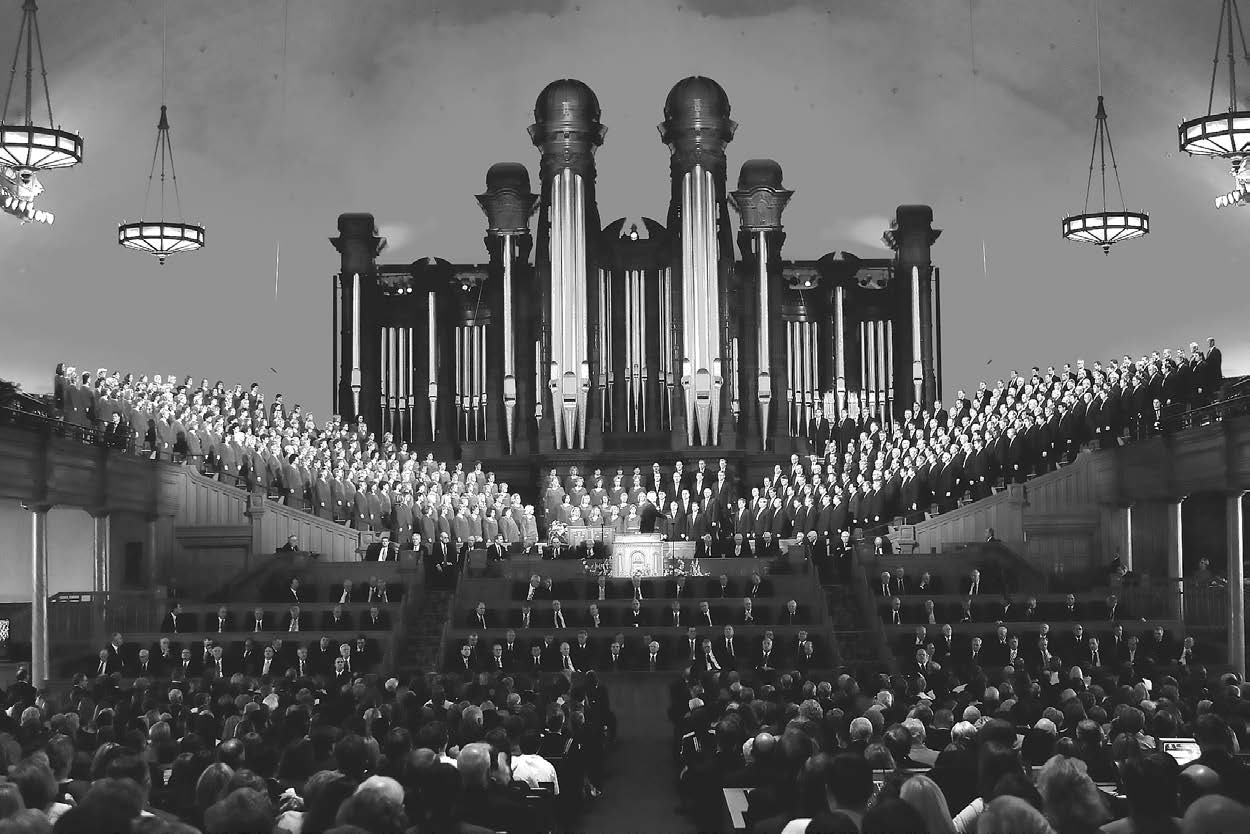 Tabernacle Choir in 1991, photo by Christina Smith. © Intellectual Reserve, Inc.
Tabernacle Choir in 1991, photo by Christina Smith. © Intellectual Reserve, Inc.
It was an immediate success. The New York City Telegraph gave this praise: “Somewhere in the world there may be more than one brilliant choral organization other than the Mormon Tabernacle Choir, but there is no broadcasting in America today to equal the one that comes from the air over the National Broadcasting System.”[9] NBC president M. H. Aylsworth wired congratulations: “Your wonderful Tabernacle program is making great impression in New York. Have heard from leading ministers. All impressed by the program. Eagerly awaiting your next.”[10]
Well, what came next is more than ninety years of continuous network broadcasting—the longest run in history. Today, Music and the Spoken Word is carried to the world on radio, television, cable, and YouTube, in addition to a live stream each Sunday morning at 9:30 a.m. mountain standard time. These platforms can be accessed from anyplace in the world, and they reach a weekly audience of millions.
Among those audience members from the past were my grandparents. They tuned in on an old upright Philco radio from the Idaho family farm during the 1930s. My mother has since handed that radio down to me, and it is a cherished family heirloom. It still works, even with antique tubes and wiring. Though it embodies so much history, its wooden frame is smooth and mostly unmarked. For me, it is a visual and auditory link to the early years of Music and the Spoken Word.
In my mind’s eye, I can see my forebears gathered around the radio on a Sunday morning, tuning in to hear the choir’s weekly broadcast. Their tiny farm town was hundreds of miles away from Salt Lake City, so it must have seemed like a miracle that they could hear the Tabernacle Choir in their own living room! Week after week, they looked forward to the program’s uplifting music and familiar refrains: “From the Crossroads of the West, we welcome you to a program of inspirational music and spoken word.”
Literally every week since 15 July 1929, Music and the Spoken Word has seen its audience through war and depression, peace and prosperity. Its inspirational programming has steadied troubled hearts, brought peace, added upon joys, and led one generation after another to God. And while the times and technology have certainly changed, the essence of this broadcast has remained the same week after week, encouraging, comforting, and guiding its audience to greater good. In a world of increasing negativism, this timeless treasure of music and message is a beacon of hope and harmony that calms troubled hearts. In a world of loud noises and confusing voices, the choir’s broadcast is a secure and steady anchor of timeless truth and reassuring joy. The broadcast has endured through the pages of history, always there—steady, reliable, and strong in uncertain times.
In 1954, Life magazine commemorated the twenty-fifth year of Music and the Spoken Word with these words: “Those who know this program need no arguments for listening to it. . . . Millions have heard [the choir], and more millions, we hope, will hear them in years to come. It is a national institution to be proud of, but what matters more is that Americans can be linked from ocean to ocean and year to year by the same brief respite from the world’s week, and by a great chord of common thoughts on God and love and the everlasting things.”[11]
Among all of the praise and awards Music and the Spoken Word has gathered over the years, and they are many, this may be its most important achievement: the way it has connected with generation after generation over the decades. Somehow, the choir and its music has found a way to touch hearts, consistently, for more than ninety years and counting.
Music and the Spoken Word was inducted into the National Association of Broadcasters Hall of Fame in 2004, joining such legends as Bob Hope, Edward R. Murrow, Bing Crosby, Paul Harvey, and Oprah Winfrey. The broadcast was inducted into the National Radio Hall of Fame in 2010. Other awards and honors given to the choir include a Grammy for its rendition of “Battle Hymn of the Republic” (1959), the Peabody Award (1944, 1962), the Freedoms Foundation’s George Washington Honor Medal (1981), two Emmy Awards (1987, 2013), the National Medal of Arts (2003), the Mother Teresa Award (2006), and the Library of Congress’s National Recording Registry (2004) for the choir’s 1958 recording of Messiah. The choir’s recordings regularly top the Billboard charts and include multiple gold and platinum records.
As its worldwide reach expanded through weekly broadcasts, the choir continued to tour nationally and internationally, allowing more people to hear the choir in person. Their first international tour, in 1955, included performances in Scotland, London, Copenhagen, Amsterdam, Berlin, and Paris. Subsequent tours have taken the choir (along with orchestra members and support staff—a small army of more than five hundred) to the finest music halls in the world, from Jerusalem to Sydney, Mexico City to Budapest, Moscow to São Paulo, and Vienna to Tokyo. They have been on stage at the Boston Esplanade, the Hollywood Bowl, Carnegie Hall, Wolf Trap, Red Rocks, Chautauqua, Tanglewood, and Mount Rushmore, to name just a few. The choir’s largest audience for a single performance came during the opening ceremonies of the 2002 Winter Olympics, when 3.5 billion people watched as highly acclaimed conductor and composer John Williams directed the choir in a composition written specifically for them. Williams commented later, “I think the Mormon Tabernacle Choir has a glow about it, an inspirational glow. They enjoy making music that is not commercially driven in any way. These are people who are there for the joy of music. It’s not a job with them; it’s a mission.”[12]
Changing Hearts and Perceptions
And it’s not just about beautiful music, although the choir, of course, excels at that. It’s also about changing hearts and perceptions about the Church. Several years ago, choir officials conducted a survey of listeners; commenting on the results of that survey, music historian Michael Hicks noted “that the onetime emblem of the Mormon menace had become an American institution. Even a cursory examination of the country’s mass culture suggests how thoroughly it has embraced and absorbed the . . . Tabernacle Choir.” According to Hicks, the Tabernacle Choir has “come to symbolize what seem to many non-Mormons the church’s most admirable and even most ‘American’ traits: cooperation, conservatism, ceremoniousness, and the pursuit of recognition.”[13] Another historian, Reid Neilson, added, “The choral group that traces its musical roots to a hobbled-together pioneer choir is now part of America’s popular culture. The church was mainstreamed into America in large measure by its Tabernacle Choir.”[14]
Good feelings toward the choir don’t always equate to good feelings toward the Church, but they’re definitely a good start. Historian Gerald A. Petersen put it this way: “It is not unusual for a minister or layman of another religion to vigorously attack the Mormons’ beliefs while anxiously awaiting his newest recording of the Mormon Tabernacle Choir—and thereafter to use the recording as an example for his own choir to emulate.”[15]
The Nation’s Capital and the Choir
One key to the choir’s nationwide respect has been its many high-profile performances in the nation’s capital. The Washington, DC, area is the choir’s most-visited location outside Utah with seventeen visits since 1911.[16] Those visits include seven presidential inaugurations and sold-out concerts where U.S. presidents, dignitaries, politicians, and other civic and business leaders—along with countless residents from all walks of life—were their honored guests. It’s an appropriate setting for “America’s Choir” which is the unofficial title given by President Ronald Reagan, who said, “At my first inauguration as president of the United States, I wanted very much to reignite the fires of liberty and re-inspire the American spirit. And no one sings the anthems of America quite like the Mormon Tabernacle Choir.” Reagan continued, “The Choir’s singing was a highlight of our inauguration, as we knew it would be. I’m sure I speak for all Americans when I say thank you for saying so well what all of us feel about this land of the free and home of the brave. There is no more inspirational moment for any American—and that includes Ronald Reagan—than to hear the Mormon Tabernacle Choir sing ‘Glory, glory, hallelujah, His truth is marching on.’”[17]
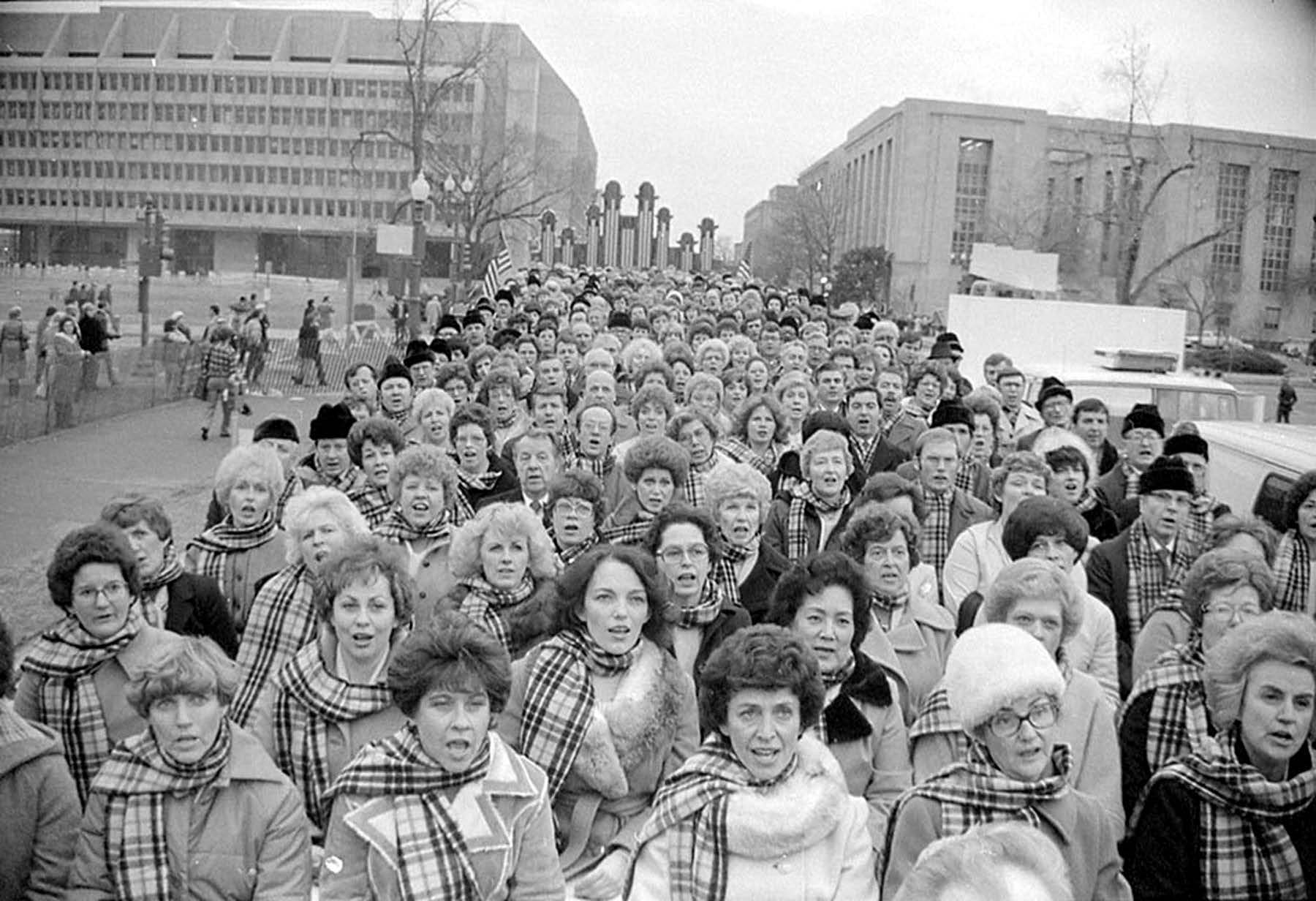 The Tabernacle Choir at President Ronald Reagan’s inaugural parade, 20 January 1981. Ronald Reagan Presidential Library
The Tabernacle Choir at President Ronald Reagan’s inaugural parade, 20 January 1981. Ronald Reagan Presidential Library
The first time the choir traveled to Washington, DC (and the first time they performed for a U.S. president) was in November 1911—sixty-four years after the pioneers arrived in the Salt Lake Valley, fifteen years after Utah became a state, and eighteen years before the choir launched its nationwide broadcast. It was part of a fifty-five-hundred-mile, twenty-three-city public relations tour across the country and to major cities along the East Coast.[18] And it came at a critical time for the Church’s public relations. Popular bias against the Church was strong, and many people across the nation still viewed Latter-day Saints with suspicion. This sentiment was particularly evident just a few years earlier during the nationwide controversy over the seating of Latter-day Saint Apostle Reed Smoot in the U.S. Senate. The Smoot hearings, as they came to be known, drew national attention and revealed that many Americans, including leaders in Washington, held strong prejudices and misconceptions about the Church.
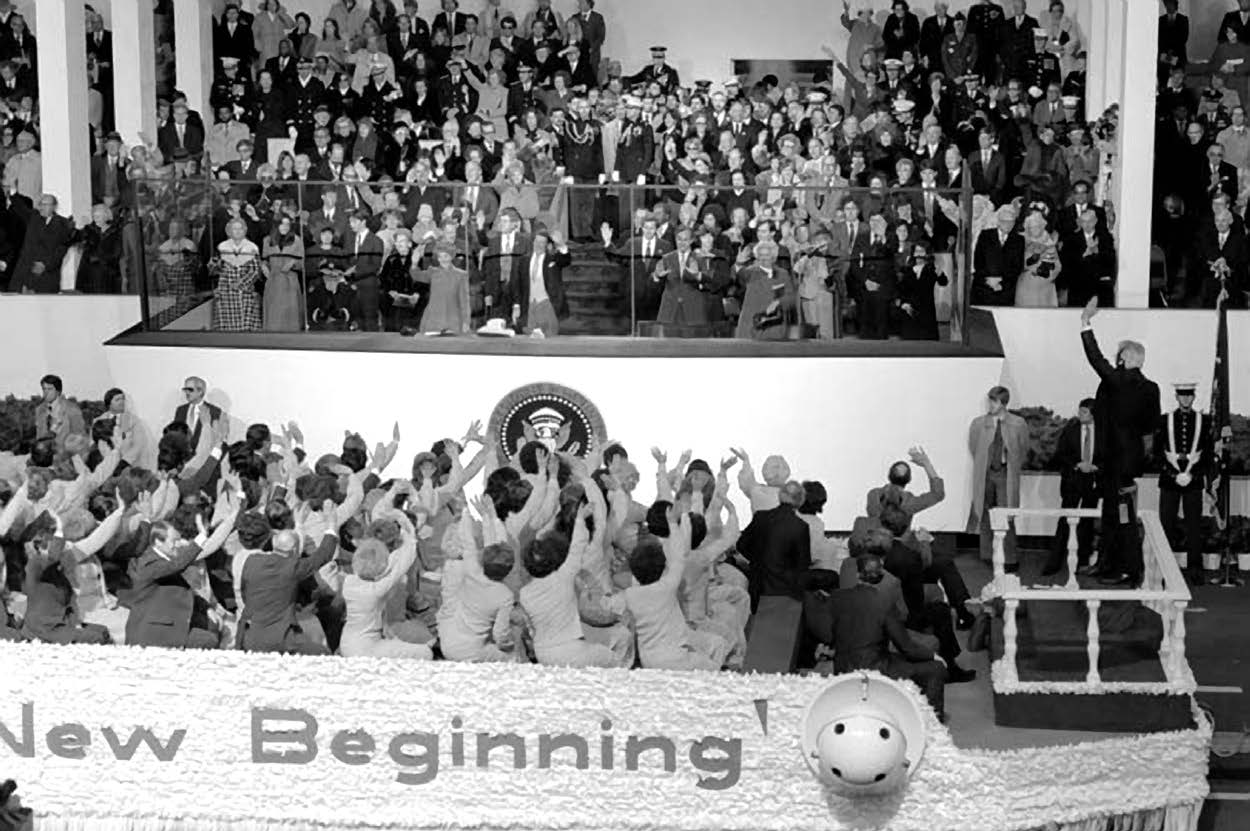 The Tabernacle Choir float during President Reagan’s inaugural parade. Ronald Reagan Presidential Library.
The Tabernacle Choir float during President Reagan’s inaugural parade. Ronald Reagan Presidential Library.
It was in this climate that the choir arrived in the nation’s capital for a command performance in the East Room of the White House to sing for President and Mrs. Taft and about fifty other guests, including a group of senators and ambassadors. This would begin a tradition of singing for presidents that would reach into the twenty-first century.[19]
Favorable comments by music critics along the way boosted the image of the Latter-day Saints, yet reception during the tour varied widely as recurrent antagonistic feelings in some areas of the country were present. In several cities, hall managers refused to book the choir, and campaigns were organized to discourage people from attending choir concerts. In Philadelphia, local clergy circulated a petition decrying the appearance of the choir, saying that it was “Mormon propaganda” and calling for a boycott of the performance. The effort failed.[20] In Richmond, Virginia, protests erupted and the local newspaper opined that the choir’s tour was a plot to “propitiate favor for Mormonism with the uninformed and thoughtless.”[21] And the Union Theological Seminary asked people to “give up fine music rather than lead your fellowman toward [the] standards of Joseph Smith.”[22] Yet performing at the White House and for the president was a signal to the nation of the acceptance of religious diversity and the acknowledgment that members of the restored Church of Jesus Christ were part of America. As one historian noted, “The president’s invitation was a clarion call that religious prejudice would not be tolerated in the United States.”[23]
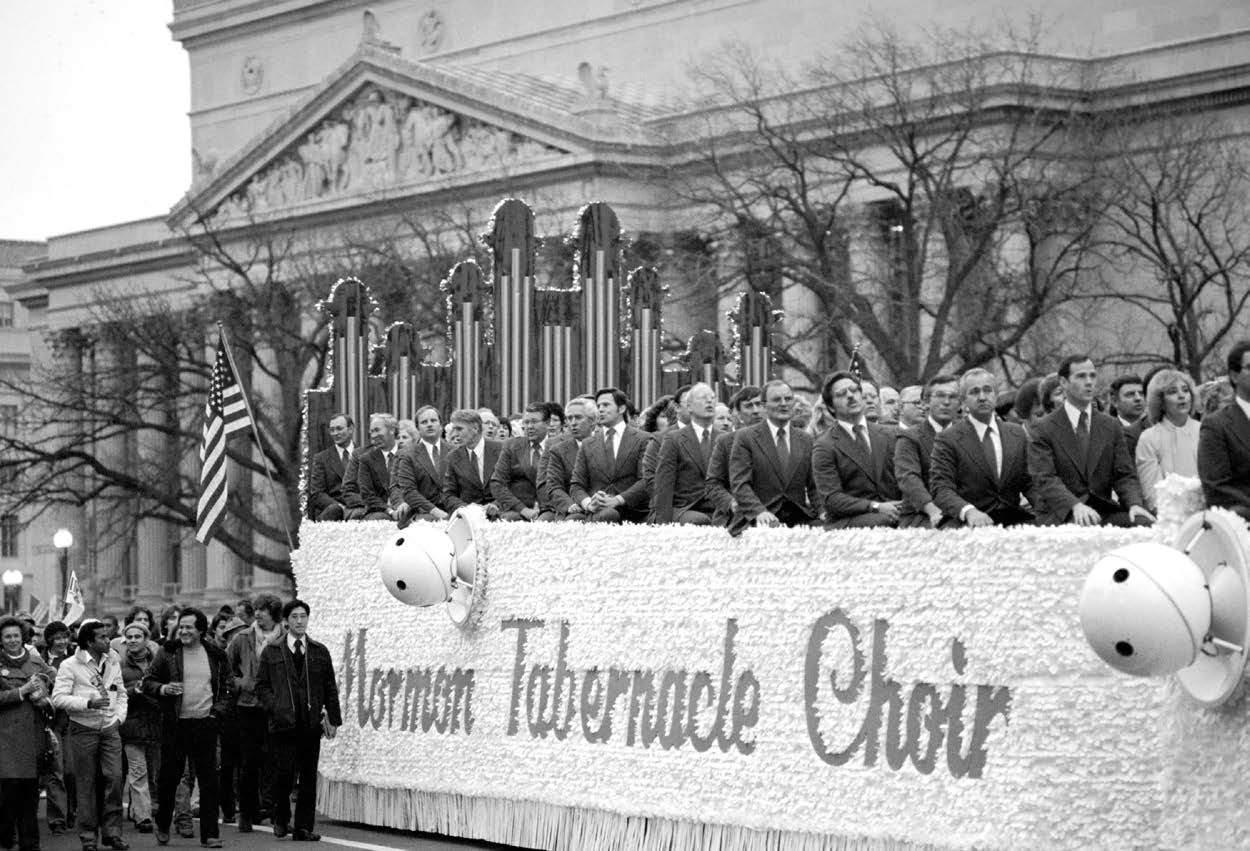 The Tabernacle Choir float at President Reagan’s inaugural parade. Ronald Reagan Presidential Library
The Tabernacle Choir float at President Reagan’s inaugural parade. Ronald Reagan Presidential Library
The choir did not perform in the nation’s capital again for forty-seven years, returning in 1958 to perform for President Dwight D. Eisenhower at the White House. This tour included three performances and a recording of Messiah with the Philadelphia Orchestra and Eugene Ormandy, who once called the choir “the greatest choir in the world.”[24]
After that, visits to Washington, DC, became much more frequent as the choir became more embedded in Americana and its cultural and musical landscape. In February 1964, U.S. president Lyndon B. Johnson [LBJ] asked President David O. McKay if the choir could come to sing at the White House that summer. President McKay was thrilled with the opportunity; a date was agreed upon and a tour arranged. On 23 July, while on their New York World’s Fair Tour, [25] the choir sang at the White House under the direction of Richard P. Condie.
Before the year was up, and upon the presidential election of LBJ in the fall of 1964, the choir was invited to return to Washington, DC, to perform at President Johnson’s inaugural ceremonies. The choir sang “This Is My Country” at the U.S. Capitol in the official swearing-in ceremony; LBJ had the stand at the capitol rebuilt to accommodate the choir. He remarked that the choir was “the best thing connected with the inaugural ceremonies.” It was the first of seven performances at presidential inaugurations, a tradition that has earned the choir nicknames like “the state choir of the republic” or “the anointed voice of America’s civil religion.”[26] President David O. McKay called this performance for President Johnson “the greatest single honor that has come to the Tabernacle Choir.”[27] It lifted the reputation and visibility of the choir and the Church across the country.
Since then, the choir has performed for U.S. presidents of both parties in many settings, including swearing-in ceremonies, inaugural parades, inaugural opening ceremonies, and devotional programs. The choir is nonpartisan, and its participation in these events is not an implied support of party affiliations or politics but rather a demonstration of its support for freedom, civility, and the peaceful transition of power.[28]
One national publication reflected, “The Tabernacle Choir has performed for royalty and heads of state from the world over, but never has it lost the common touch, the ability to stir the hearts of all mankind as it lifts its collective voices in singing of the values we all cherish and in praising the God who created us all.”[29]
Personal Experience with the Choir
I have been involved with the choir long enough to get a sense of its enduring legacy. For me, as the program’s announcer, that legacy begins with nineteen-year-old Ted Kimball. The son of Tabernacle organist Edward P. Kimball, Ted served as the first announcer, filling this role for several months before leaving to serve a full-time Church mission. Then, in June 1930, a twenty-four-year-old announcer from KSL Radio, Richard L. Evans, was chosen to replace him. In time, he would begin to add short thoughts, called sermonettes, to the weekly program. Just four years later, he received a national award as the best radio announcer in the country. He subsequently served as an Apostle for the Church, a nationally syndicated newspaper columnist, and the president of Rotary International. Perhaps no one has had a greater impact on Music and the Spoken Word than Richard L. Evans. He was the broadcast’s announcer and writer for forty-one years; he produced the program each week and toured with the choir, all while serving as a General Authority for The Church of Jesus Christ for more than thirty years.
After Elder Evans, J. Spencer Kinard spent eighteen years as the announcer of Music and the Spoken Word, and then I was asked by Church President Gordon B. Hinckley to serve in this assignment. “This calling will change your life,” he told me. My first broadcast was on 25 November 1990, the Sunday before Thanksgiving. Now, more than three decades later, I deeply understand the truth of President Hinckley’s words—this calling has changed my life. It has been a marvelous blessing, a weighty responsibility, and a sacred trust and honor. My life and my family’s lives are undeniably better because of it.
President Hinckley said something else that still rings in my ears all these years later. He said with great earnestness, “Each week, your Spoken Word should be an inspirational gem.” Every time I prepare one of these weekly messages, I ponder his charge. I ask myself: Is this message inspirational? Does it enlighten and uplift? Does it add an insight and perspective that is wise and interesting and encouraging? I can sincerely say that each message is carefully considered and lovingly written, and each is motivated by a genuine desire to share some timeless wisdom, an eternal truth, or a principle that will teach and lift and inspire.
I have been blessed to travel the world with the choir—from Jerusalem to Berlin to Paris to Toronto to Washington, DC, to Dallas to Los Angeles and many points in between—announcing and emceeing countless concerts and performances, as well as presenting more than sixteen-hundred Spoken Word messages. I may be biased, but I believe the Tabernacle Choir at Temple Square is the greatest choir of all time, and it truly just keeps getting better. I cannot express the joy, blessing, comfort, and strengthening influence it has been for me to begin every Sunday morning since 1990 with these dedicated, talented singers and musicians at my side. There’s nothing like this remarkable broadcast with this remarkable choir and orchestra anywhere in the world.
In 1974 Richard Condie concluded his seventeen-year tenure as conductor of the Tabernacle Choir with a simple gesture. At the end of his final Music and the Spoken Word broadcast, he gave the choir the downbeat for the final song and then, with no fanfare, simply set down his baton and stepped down from the podium as the choir went on singing. Since that day, the director at the conclusion of every performance has set down his baton, turned to the audience, and joined the choir in singing those poignant words, “God be with you till we meet again.”[30]
This song, which continues to be the choir’s signature signoff, is a fitting expression of our mission: “We hope we have helped you feel a little closer to God today, and we hope that feeling can continue in your heart until we have a chance to be with you again.”
Beyond the tours and recordings, the awards and the accolades, no matter how well known the choir may become around the world, it will always be composed of individuals—thousands of them over the years—who still “make the air with music ring.” All who associate with the choir—and most who hear the choir perform—know full well that its mission is about far more than beautiful music or exemplary expression and tonality. These singers see themselves as musical ambassadors of Jesus Christ. Their mission is to share his love, his truths, and his Spirit with all who listen.
That has always been the focus of the Tabernacle Choir—to bless the people who gather to be uplifted, to be filled, and to find what they are missing inside themselves. Listeners who tune in to the broadcast and come to the Tabernacle, the Conference Center, and concert halls around the world speak not only of what they hear but also of what they feel. The heart of the choir’s message is simple: “God lives. Jesus is the Christ. Life is worth living. There is hope and healing ahead.” They don’t sing words, they sing feelings. As former organist John Longhurst said, “The choir members come to this work with a high sense of purpose, a very strong unifying sense of mission, and when they perform you can sense this spirituality, this deep inner commitment musically and spiritually to what they are doing.”[31]
As one of the least of those who have been part of the choir’s longstanding legacy, I leave you with the same words with which I have concluded the broadcast each week for more than thirty years: “Until we meet again, may peace be with you . . . this day and always.”
Appendix
Tabernacle Choir Trips to the Washington, DC Area
Year | Trip purpose | Location |
1911 | American Land & Irrigation Congress Tour; | Washington, DC, White House |
1958 | Grand American Tour | Washington, DC, White House |
1964 | New York World’s Fair Tour | Washington, DC, White House |
1965 | Inauguration of President Lyndon B. Johnson | Washington, DC |
1969 | Inaugural concert for President Richard Nixon | Washington, DC |
1970 | National Christmas Tree Lighting Ceremonies | Washington, DC |
1973 | Inauguration of President Richard Nixon | Washington, DC |
1974 | Washington, DC, Temple Tour | Washington, DC |
1976 | U.S. Bicentennial Tour | Washington, DC |
1981 | Inauguration President Ronald Reagan | Washington, DC |
1989 | Inauguration of President George H. W. Bush | Washington, DC |
1995 | American Requiem Tour | Washington, DC, Kennedy Center |
2001 | Inauguration parade for President George W. Bush | Washington, DC |
2003 | Northeast United States Tour | Wolf Trap, Fairfax County, Virginia |
2011 | Eastern States Tour | Wolf Trap, Fairfax County, Virginia |
2015 | Atlantic Coast Tour | Bethesda, Maryland |
2017 | Inauguration of President Donald Trump | Washington, DC |
Notes
[1] Heidi Swinton, America’s Choir: A Commemorative Portrait of the Mormon Tabernacle Choir (Salt Lake City: Deseret Book, 2004), 99. In October 2018 the Mormon Tabernacle Choir changed its name to the Tabernacle Choir at Temple Square.
[2] For additional information, and a previous work on portions of this content, see Lloyd Newell and Heidi Swinton, Pioneer Magazine 64, no. 2 (2017): 2–16.
[3] William Clayton, “Come, Come, Ye Saints,” Hymns (Salt Lake City: The Church of Jesus Christ of Latter-day Saints, 1985), no. 30.
[4] Clayton, “Come, Come, Ye Saints.”
[5] Other conductors in the early days included Stephen Goddard (choir leader from Nauvoo), James Smithies, Charles John Thomas, Robert Sands, Ebenezer Beesley (choir conductor from 1860–89), Evan Stephens (1889–1916), Anthony C. Lund (1916–35), J. Spencer Cornwall (1935–57), Richard P. Condie (1957–74), Jay E. Welch (1974), Jerold D. Ottley (1975–98), Craig Jessop (1999–2008), and Mack Wilberg (2008–present). Compositions by several of these conductors are included in the Church’s current hymnal.
[6] When necessary to accommodate larger audiences, the choir also performs in the Conference Center, a nearly twenty-two-thousand-seat facility north of Temple Square, dedicated in 2000. For example, the choir’s annual Christmas concerts and its weekly Music and the Spoken Word broadcasts during the summer months originate from the Conference Center.
[7] E. A. McDaniel, Utah at the World’s Columbian Exposition (n.p., self-pub., 1894), 14; digitized by David O. McKay Library, Brigham Young University–Idaho .
[8] At the enticement of CBS founder and broadcast pioneer William S. Paley, in 1932 the broadcast switched to the CBS Radio Network, where it remains today.
[9] Swinton, America’s Choir, 102. “The Choir’s 300 members practiced for a month before the first live broadcast, holding a final ‘radio dress rehearsal’ the week before. The chief divisional engineer of NBC called it an ‘epic’ event, with 10,000 radio fans eagerly awaiting the program. In the early broadcasts, the announcer would aim the one microphone in the direction of whichever section was singing at the moment.”
[10] Swinton, America’s Choir, 104.
[11] Richard L. Evans, From the Crossroads (New York: Harper and Brothers, 1955), 14.
[12] Swinton, America’s Choir, 3.
[13] Michael Hicks, Mormonism and Music: A History (Urbana: University of Illinois Press, 1989), 166.
[14] Reid Neilson, Exhibiting Mormonism: The Latter-day Saints and the 1893 Chicago World’s Fair (New York: Oxford, 2011), 109.
[15] Gerald A. Petersen, More Than Music: The Mormon Tabernacle Choir (Provo, UT: Brigham Young University Press, 1979), 36.
[16] See appendix.
[17] The Tabernacle Choir at Temple Square, “Where Does the Title America’s Choir Come From?” The Tabernacle Choir Blog, 15 January 2014.
[18] Several of the stops took choir members back to significant sites in Church history—Omaha (near Winter Quarters, Nebraska); Toledo (near Kirtland, Ohio); Rochester (Palmyra, New York). The choir performed three times a day for ten days in Madison Square Garden in New York City for the opening of the American Land and Irrigation Exposition.
[19] See Charles Jeffrey Calman, The Mormon Tabernacle Choir (New York: Harper and Row, 1979), 76–77.
[20] See Swinton, America’s Choir, 73.
[21] See Mormon Studies Review 2 (2015): 134–39; “East Fights West at the Land Show,” New York Times, 4 November 1911, 7; Hicks, Mormonism and Music, 156–57.
[22] Hicks, Mormonism and Music, 156–57.
[23] Calman, Mormon Tabernacle Choir, 77.
[24] Calman, Mormon Tabernacle Choir, 178.
[25] The choir was part of the “Mormon Pavilion” at the New York World’s Fair. The pavilion also included a replica of the Salt Lake Temple, murals depicting the history of the Church, and the film Man’s Search for Happiness. The purpose was to introduce what many then considered an obscure religion to a national audience. Familiar with the popular Music and the Spoken Word, which by that time had an immense following, the fair leadership pressed for the choir to perform. On Sunday, 26 July, the choir performed in the Texas Pavilion Music Hall, filling nearly all twenty-four-hundred seats. They also performed the following day in front of record numbers. The fair was the choir’s first stop on a 1964 nationwide tour that included stops at the White House in Washington, DC, as well as Rochester, Atlanta, Cleveland, Milwaukee, New Orleans, and Houston. The choir had a long history of performing at World’s Fairs, beginning at the World’s Columbian Exposition in 1893–94 in Chicago. The choir went on to sing in the 1934 Century of Progress Exposition in Chicago, the California-Pacific International Exposition in San Diego in 1935, and the Seattle World’s Fair in 1962.
[26] Michael Hicks, The Mormon Tabernacle Choir: A Biography (Urbana: University of Illinois Press, 2015), ix.
[27] Hicks, Mormon Tabernacle Choir, 124.
[28] Another noteworthy choir that should be mentioned is the Mormon Choir of Washington, DC, now known as the Washington DC Temple Choir. This respected choir was formed under the direction of Dr. Eugene Morlan in the fall of 1980. The choir is composed of singers and musicians selected by audition, with a current membership of eighty to one hundred from approximately fifty congregations in the Maryland and Virginia regions. The choir performs twelve to eighteen concerts each year and continues to include the traditional opening night of the Festival of Lights each Christmas at the Washington D.C. Temple Visitors’ Center. The choir has also performed in the priesthood room on the seventh floor of the Washington D.C. Temple; the East Room of the White House; Brucker Hall on Fort Myer in Arlington, Virginia; the Kennedy Center for the Performing Arts; and the Maryland Statehouse at Annapolis. See dctemplechoir.org; see also Florian H. Thayn and Julian C. Lowe, History of the Mormons in the Greater Washington Area: Members of the Church of Jesus Christ of Latter-Day Saints in the Washington, D.C. Area, 1839–1991 (Washington, DC: Community Printing Service, 1991).
[29] “The Salt Lake Mormon Tabernacle Choir,” American Organist, December 1988, 62.
[30] Jeremiah E. Rankin, “God Be with You Till We Meet Again,” Hymns, no. 152.
[31] Swinton, America’s Choir, 10.
